Dynamic Energy Saving – the E in EP35
Gigabyte introduces its Dynamic Energy Saver, signified by the "E" added to the front of its motherboard names. This is achieved through a combination of hardware and software – the motherboard features several little LEDs at the top by the CPU socket that are coloured from green through to red. Green signifies low power (phase) use and red, high. If you really don't like them though, they can thankfully be turned off.While we don't usually go for blinking motherboard LEDs, Gigabyte has changed our opinion in this case and does it very well – it’s intuitive and easy to see, well, providing it isn't stuffed in the depths of your case under your desk. This is unlike the Asus Republic of Gamer boards, for example, which have LEDs dotted here there and everywhere so it requires a keyhole surgical camera to find them once the hardware is installed.
In addition to this, the board layout hasn't changed an awful lot, most notably now is the software side which comes in the usual flashy look – I imagine that words like "streamlined", "industry leading" and "futuristic" buzz words were used in the design meeting. However I use the word design loosely; as good as Taiwanese engineering is, they seem to utterly lack the ability to make something user friendly.
Look at the picture below and pick out a button. Go on.
The three ovals to the right? Nope. The little green button to the left – what does that do? Any guesses? It turns on/off the motherboard LEDs – that was obvious, wasn't it. What does the @ circle do? It launches the @BIOS flashing utility – that's just what you'd expect power saving software to include, right?
Thankfully the manual is the saving grace and details exactly what is and isn't clickable. The level buttons are various CPU voltage differences which offer three levels of power saving – that's great, but what voltages? We investigated and from what we can tell there are very small voltage changes and far less than what the Dynamic Throttling indicates. We were going to suggest that Gigabyte could bolt on its EasyTune software too to make the power profiles customisable and correlate to overclocking settings. However, when we came to overclock we found the software cannot work outside of the default CPU frequencies.
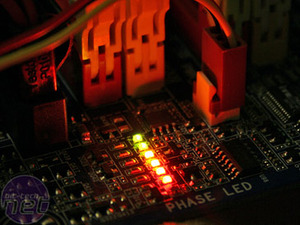 At the top the CPU power records its current power use, and the power meter records how much power you've used in total, as well as what you've saved by using the DES software. While interesting to know, it's a bit willy waving – it only records the CPU and not the whole system, so you don't quite know how much your entire PC is costing you.
At the top the CPU power records its current power use, and the power meter records how much power you've used in total, as well as what you've saved by using the DES software. While interesting to know, it's a bit willy waving – it only records the CPU and not the whole system, so you don't quite know how much your entire PC is costing you. We'd like to see an option to input how much a kilowatt of power costs in your area – this way the software can automatically calculate how much your PC is costing you. I’m sure something like that would be an excellent utility for those on a budget.
The cylinders are animated and change in line with the board LEDs – Gigabyte has this part right as both are intuitive and easy to understand. Our board has six power phases, so there are six cylinders in the software, but DQ6 boards with twelve power phases will have twelve cylinders instead.
The CPU voltage and throttling levels are also dynamic and real time, but again, unspecific about what voltage or frequency is currently being applied. While we like and appreciate that, some prefer simplicity so an option for exact values would be good.
We checked how much with CPU-Z and found that the throttling is non-existent. We disabled the native Intel EIST and C1E states in the BIOS so they didn't interfere but found that even though the Gigabyte software reported CPU throttling it doesn't actually translate to a loss of frequency – the button, in effect, does nothing. There are some slight voltage changes between the settings, but it's on the level of hundredths of volts when we used an Intel Core 2 Extreme QX9650.
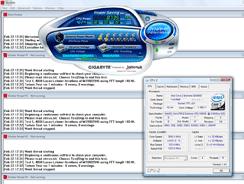

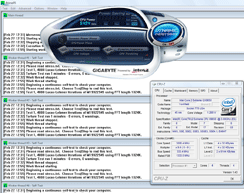
Left to Right: 1) No CPU load, 2) CPU at full load with Prime95, 3) DES disabled, CPU at full load. Click to enlarge
Power Consumption
We will visit the power consumption of "Energy Efficient Motherboards" in more depth in a future article, where we’ll discuss their performance, software, hardware and actual energy savings.When we ran the Dynamic Energy Saver (DES) software on the Gigabyte board, we also enabled the CPU Throttling option to maximise the power saving potential. The effect at idle is a quite significant 13W for the Gigabyte. The Asus EPU on the P5E3 Deluxe WiFi AP @n saves slightly more at 14W, but having said that, there should be significantly more to save before on a board that has way more features and eight phase power over the Gigabyte’s six.
The load values are also respectively similar with 3W difference between the two modes. However, it's important to remember that the Asus EPU actually automatically overclocks the CPU front side bus by 6.4 percent when loaded, increasing the performance of the system for 3W less. Gigabyte doesn't do this – the maximum CPU frequency is what you set it to.
The MSI P35 Platinum doesn't feature any specific software, but after speaking to the MSI product managers recently, we were told the company builds on the philosophy of engineering minimalism that offers the maximum effect. In this respect, the 108W at idle and lowest 155W load is exceptionally good.
However, even the Abit IX38 which also doesn't feature specific energy efficient features and it uses a more powerful Intel X38 chipset only sits at 106W idle and a very reasonable 157W load.
All things considered, the Gigabyte software works well and provides some actual energy savings, but it's very hard to quantify against the competition directly. And remember workload over time can also provide some interesting results: if a board performs faster it will save power in the long term. We'd suggest that even though Gigabyte may make a large fuss over its energy efficient products, that doesn't mean to say other solutions on the market may work any less effectively when providing an inherent power saving.

MSI MPG Velox 100R Chassis Review
October 14 2021 | 15:04


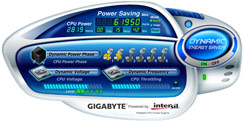
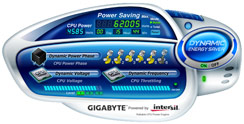
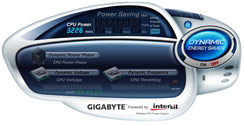







Want to comment? Please log in.